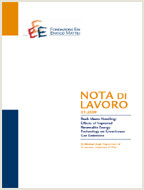Bending The Learning Curve

Date
14.07.2015
14.07.2015
Authors
Jan Witajewski-Baltvilks (Fondazione Eni Enrico Mattei, Centro Euro-Mediterraneo sui Cambiamenti Climatici CMCC); Elena Verdolini (Fondazione Eni Enrico Mattei, Centro Euro-Mediterraneo sui Cambiamenti Climatici CMCC); Massimo Tavoni (Fondazione Eni Enrico Mattei, Centro Euro-Mediterraneo sui Cambiamenti Climatici CMCC, Politecnico di Milano)
JEL Code
Q42, Q55, C55, C26
Q42, Q55, C55, C26
Keywords:
Learning Curve, Renewable Technologies, Integrated Assessment Models
Learning Curve, Renewable Technologies, Integrated Assessment Models
Publisher
Climate Change and Sustainable Development
Climate Change and Sustainable Development
Editor
Carlo Carraro
Carlo Carraro
This paper aims at improving the application of the learning curve, a popular tool used for forecasting future costs of renewable technologies in integrated assessment models (IAMs). First, we formally discuss under what assumptions the traditional (OLS) estimates of the learning curve can deliver meaningful predictions in IAMs. We argue that the most problematic of them is the absence of any effect of technology cost on its demand (reverse causality). Next, we show that this assumption can be relaxed by modifying the traditional econometric method used to estimate the learning curve. The new estimation approach presented in this paper is robust to the reverse causality problem but preserves the reduced form character of the learning curve. Finally, we provide new estimates of learning curves for wind turbines and PV technologies which are tailored for use in IAMs. Our results suggest that the learning rate should be revised downward for wind power, but possibly upward for solar PV.
***
Suggested citation: Jan Witajewski-Baltvilks, Elena Verdolini, Massimo Tavoni, Bending the learning curve, Energy Economics, Volume 52, Supplement 1, December 2015, Pages S86-S99, ISSN 0140-9883, http://dx.doi.org/10.1016/j.eneco.2015.09.007
